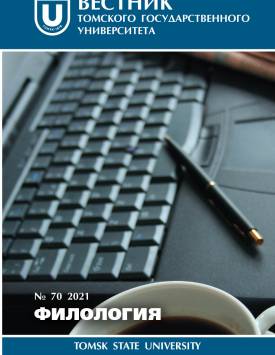Varlam Shalamov and Nikolay Gumilyov: On the Poetic Genealogy of the Author of Kolyma Tales
The article examines a very little-studied issue: the most important aspects of Varlam Shalamov’s poetry system formation, in particular, the influence of Nikolay Gumilyov’s traditions on his artistic consciousness. The aim of the study is to trace the lines of continuity and opposition to the master of acmeism that are fundamentally significant in Shalamov’s poetry. The analysis involves not only Shalamov’s poetic heritage, but also his essay and epistolary prose (letters to N.Ya. Mandelstam, N.I. Stolyarova, essays “Poetry Intonation”, “Poet from Within”, “Russian Poets of the 20th Century and De-Stalinization”, “Library of the Poet”). The study mainly employed comparative (Shalamov’s and Gumilyov’s art systems, theoretical orientations and poetic thinking principles are compared) and hermeneutic methods. The significance of Shalamov and Gumilyov in the history of Russian poetry is paradoxically similar: both became a kind of “discoverers of new lands”. In case of Gumilyov, it is primarily about exotic spheres. Shalamov, who called himself “the only Russian poet who showed the soul of man in the camp Far North”, acquainted readers with the world of permafrost, suffering and “dehumanization”. The affinity of Shalamov and Gumilyov also concerns creative orientations. First of all, it is acmeistic principles, which played the main role in Gumilyov’s thinking and were so important in Shalamov’s poetry. Shalamov’s understanding of artistic creativity is related to acmeistic, as the poet emphasizes objective and earthly facets, not irrational and mysterious ones. In Shalamov’s poetic system, the sphere of material images has a particularly significant role, like in acmeist lyrics (in Gumilyov’s, in particular). Material images have a deep emotional content and, at the same time, an unconditional independent value. The most important Shalamov’s ontological aspects (man and nature; life and death; creativity; poet’s mission) are conceived on the basis of subject imagery. In Shalamov’s lyrics, the reader rarely discovers abstract lyrical monologues (which is quite typical of symbolists, but deeply alien to acmeist poetry). Among the similar elements of Shalamov’s and Gumilyov’s world perception and poetry, there is a pronounced manly facet in their artistic worlds. A comparative analysis of the artistic worlds of Shalamov and Gumilyov also involves the interpretation of the sphere of nature. It is proved that the works of the two poets continue Tyutchev’ traditions. The conclusion is formulated that it was acmeism that became one of the most significant guidelines for Shalamov; continuity to Gumilyov’s interpretation of acmeist patterns is explored. The analysis allows not only understanding Shalamov’s poetic genealogy, but also tracing how powerful the influence of acmeism in the 20th-century poetry was.
Keywords
Shalamov, Gumilyov, Russian poetry, tangibility, images-masks, nature and humanAuthors
| Name | Organization | |
| Krotova Daria V. | Lomonosov Moscow State University | da-kro@yandex.ru |
References

Varlam Shalamov and Nikolay Gumilyov: On the Poetic Genealogy of the Author of Kolyma Tales | Vestnik Tomskogo gosudarstvennogo universiteta. Filologiya – Tomsk State University Journal of Philology. 2021. № 70. DOI: 10.17223/19986645/70/15
